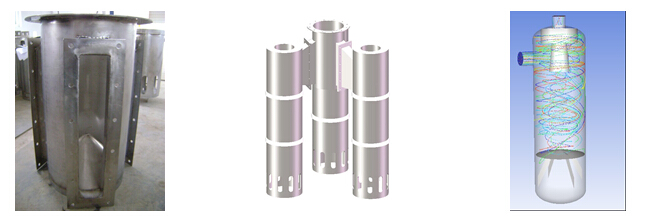The Inlet Cyclone applies centrifugal forces to the fluid mixture to achieve optimal degassing of the liquid. The incoming fluid mixture flows smoothly from the inlet pipe into the highly optimised tangential inlet zone, before entering the separation zone of the cyclone. This lessens the potential for droplet shatter and gently releases the gas from the liquid under the influence of the centrifugal forces, thereby optimising the gas / liquid separation process.
The inlet cyclone can be used for inlet momentums factor of 10 higher than half-open pipe inlets. Typically, half-open pipe inlets are used for momentums (ρV2, where ρ is bulk density, kg/m3, and V is bulk velocity, m/s) less than 1,500 Pa. Inlet cyclones have been used successfully to 15,000~45000 Pa.
Because of the centrifugal flow, large foam bubbles are broken, liquid drops are removed from the gas phase, and liquid/liquid coalescence occurs within the cyclone. A problem with some cyclones is that a poorly designed liquid outlet can shear the liquids, offsetting the benefits of the coalescence and possibly making the situation worse. For cases in which a high liquid level is required in the separator, the inlet cyclone can be submerged up to the gas outlet level. Moreover, the cylone inlet allows the use of a shorter retention time due to the rapid degass process, in which large bubble foam is minimized or eliminated. Without the cyclonic inlet, foam can occupy a considerable volume in the separator. The use of a cyclonic inlet often allows foam to be ignored as a sizing consideration. Thus, for high-capacity crude-oil separators (which are the ones most limited by foam), the cyclone inlet can significantly reduce the required vessel liquid and foam holdup volume, size, weight, and cost.
The gas-free liquid mixture travels with a swirling motion to the liquid outlet of the cyclone, where the low velocity levels ensure the best possible liquid/liquid separation.
Since this design does not incorporate any guide or flow control vanes, extremely good sand handling capabilities are obtained. It should also be noted that little or no gas will normally be present in the liquid(s) leaving the inlet cyclones. Thus, the use of inlet cyclones has the added benefit of preventing foaming in the separated liquids.
Advantages
·Handles high throughput and high inlet momentum
·Reduces the momentum of the inlet stream, thus minimising the potential for droplet shatter
·High gas/liquid pre-separation
·Improved liquid/liquid separation efficiencies
·No operational pressure limit
·Elimination of foam, reducing Operating Expenditure by reducing the need for anti-foam chemicals
·Reduces turbulence and re-circulation within the liquid section, thus promoting gravity separation
·Effectively handles slugs and surges
·Wide operational range - typically, providing 100% turndown
·Reduces the size of the inlet nozzle on a new build project
·Allows a greater fluid throughput for a set nozzle size, on a revamp project
·Easy to install in new and existing separators
·High sand loading capability
·No moving parts, thus no maintenance
Application
·Production Separators
·Test Separators
·Gas Scrubbers
·Gas Knock-Out Drums
·Slug Catchers
·Flash Drums
·Free Water Knock-Out Drums
·Floating Production Units (FPUs).

|